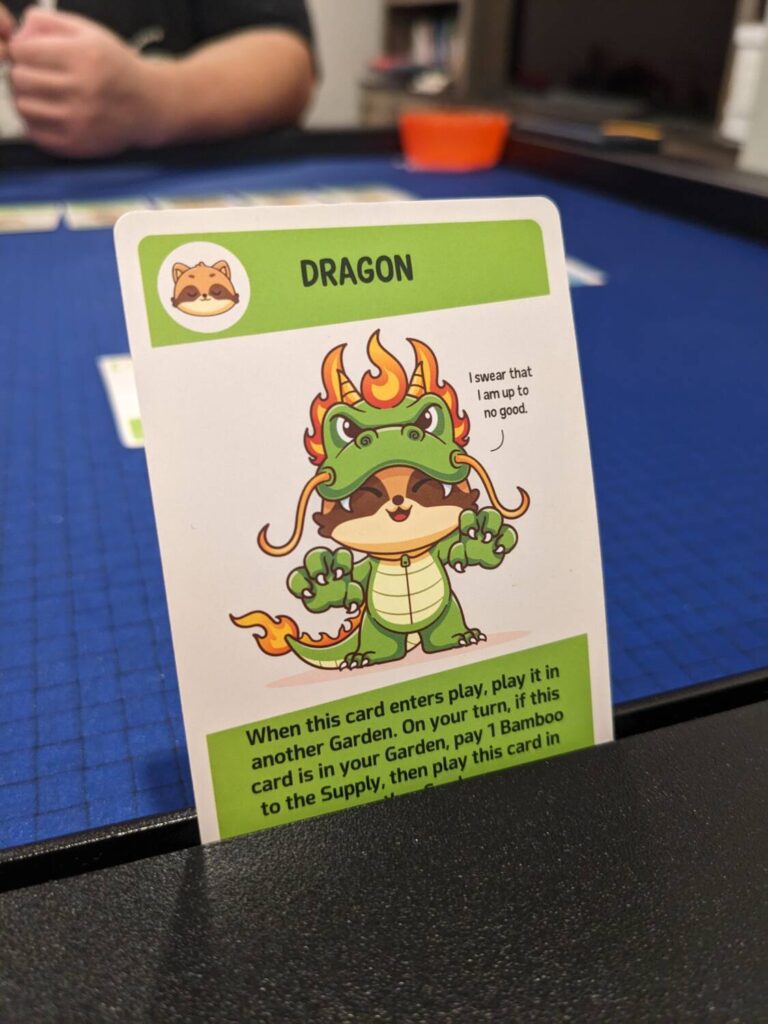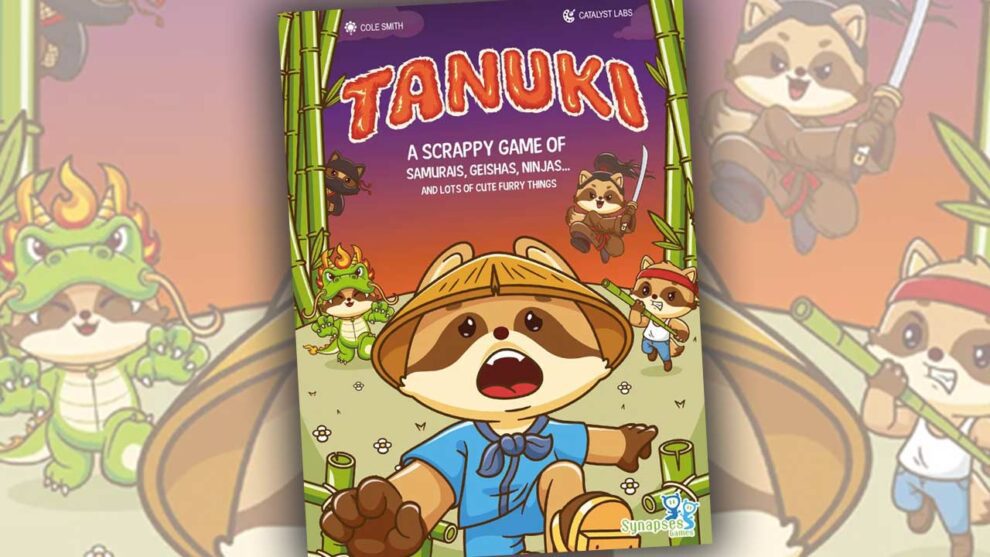Disclosure: Meeple Mountain received a free copy of this product in exchange for an honest, unbiased review. This review is not intended to be an endorsement.
I was alarmed by the text on the back of the game box for Tanuki (2024, Synapses Games): “Do you have what it takes to win in this no holds barred take that game?”
The front of the box features a cute, furry tanuki (raccoon dog, per the box) running away from other characters towards the viewer. I’m not sure what the cover image is trying to convey—should I run away from this game??—but I like a good take that game. However, I was afraid to see if this would work with my kids, particularly my son, who abhors competitive games where players can be robbed (see exhibit 147: Berried Treasure).
I opened my review copy and quickly read the rulesheet. In Tanuki, designed by Cole Smith, players begin the game with a face-up Gardener card and a face-up Samurai card in their Garden (play area). A second Gardener card is also in the Garden, face down, waiting for the game’s second half to open before being revealed by an event card buried in the draw deck.

The Gardener cards score bamboo (points) each turn they remain in a player’s Garden. Samurai protect all Gardener cards, an important distinction because Tanuki is all about stealing cards and bamboo from opponents.
Starting with a hand of three cards, turns are easy: play a card to the table, either an Action card or a Character card. If it’s an Action, do what the card says (usually, steal a card, destroy a card by placing it in the discard, copy an effect from another card, etc.). If it’s a Character, play it into your own or another player’s Garden, depending on the card text.
Then, players activate all the Character cards in their Garden, usually scoring some bamboo. Then they draw a card to ensure their turn ends with three cards in hand, with play passing to the next player. Tanuki accommodates 3-6 players.
When the second event card appears, players finish the round and tally up their bamboo. The player with the most bamboo wins!

The Big Reveal: The Kids
I put this in front of both adult groups and my kids (ages 10 and 7). Here was the big surprise—my kids, particularly the 7-year-old, loved Tanuki.
The first time the 7-year-old had his Samurai murdered, I braced myself. What is he going to do? I still remember when my wife stole a piece of pie from my son’s tableau in Berried Treasure…to this day, we still laugh about how loud the stomping was as he made his way upstairs to his room before slamming the bedroom door.
In Tanuki, I watched as his Samurai went to the discard pile…and my son started laughing. No problem. He took his next turn and played a card that let him steal one of my Gardeners to move into his Garden. He scored a bunch of points, drew his card, then made a joke about waiting to see if the 10-year-old would try to steal one of his own characters.
Things went on like this for 15 minutes. Back and forth, with nearly every turn featuring someone getting robbed, someone copying a discard effect to score double the number of points they would normally get, someone playing a card that murdered yet another character. Here’s what worked with the kids and the take-that elements of Tanuki: everyone is getting hosed every single turn, at least a little.
If the take-that elements were more sporadic, or felt more targeted, the kids wouldn’t like it. It feels like 50% of the deck is made up of cards that mess with an opponent. If it was 25%, or 10%, the game wouldn’t work for the kids. We wrapped up that first play and the kids wanted to play it again immediately, which is always a great sign.

Adults? Meh
The opinion of the adults? Straight up “meh.”
Both the adult groups and the kids thought Tanuki’s card art (and funny quotes, expressed by each character) added a lot of flavor to the proceedings. I think Tanuki loses quite a bit without cards like the cuddly-looking Emperor, Dragon, Monk, or Ninja cards. It’s not like the names of these cards are particularly special, but the artwork by Catalyst Labs makes up for this in a big way.
The cardplay with adults didn’t resonate, and that included me during the family game plays. You play a card, usually to stab someone else, then play quickly continues around the table. The randomness of top decking is a negative here, because in each of my plays, the person that drew Gardener Family cards often did better than other players, especially if opponents don’t draw cards that grant an opportunity to steal those Gardener Families into their own Garden. If someone kills off your Samurai cards, players will typically steal your now-unprotected Gardeners rather than taking the time to kill off another player’s Samurai in order to have a different player steal Gardeners for themselves.
I’m only a few games into my Tanuki career, and if I could pick, I would always play it the same way to win: build up a small army of Gardeners behind multiple Samurai. If you have even two Samurai in a low-player-count game, you are likely in good shape. Other action cards grant the chance to situationally play other Gardens to your advantage, or to steal a Gardener Family from time to time to boost scoring. Winning scores have always landed around 60, so an engine that gets you into the mid-to-high 50-point range gives you a shot.
The teach here is quick; you could slip this one to the grandparents with ease. As long as your group members can read, you’re in good shape. If Tanuki retails for $10-$15 USD, I think you’ve got something here for family game night or for kids who want to play a game with other kids—my kids are already talking about playing Tanuki with a couple of our neighbor’s kids. I don’t recommend Tanuki as a game for adults-only game night, however.
Tanuki! With the right audience, it works.












Add Comment